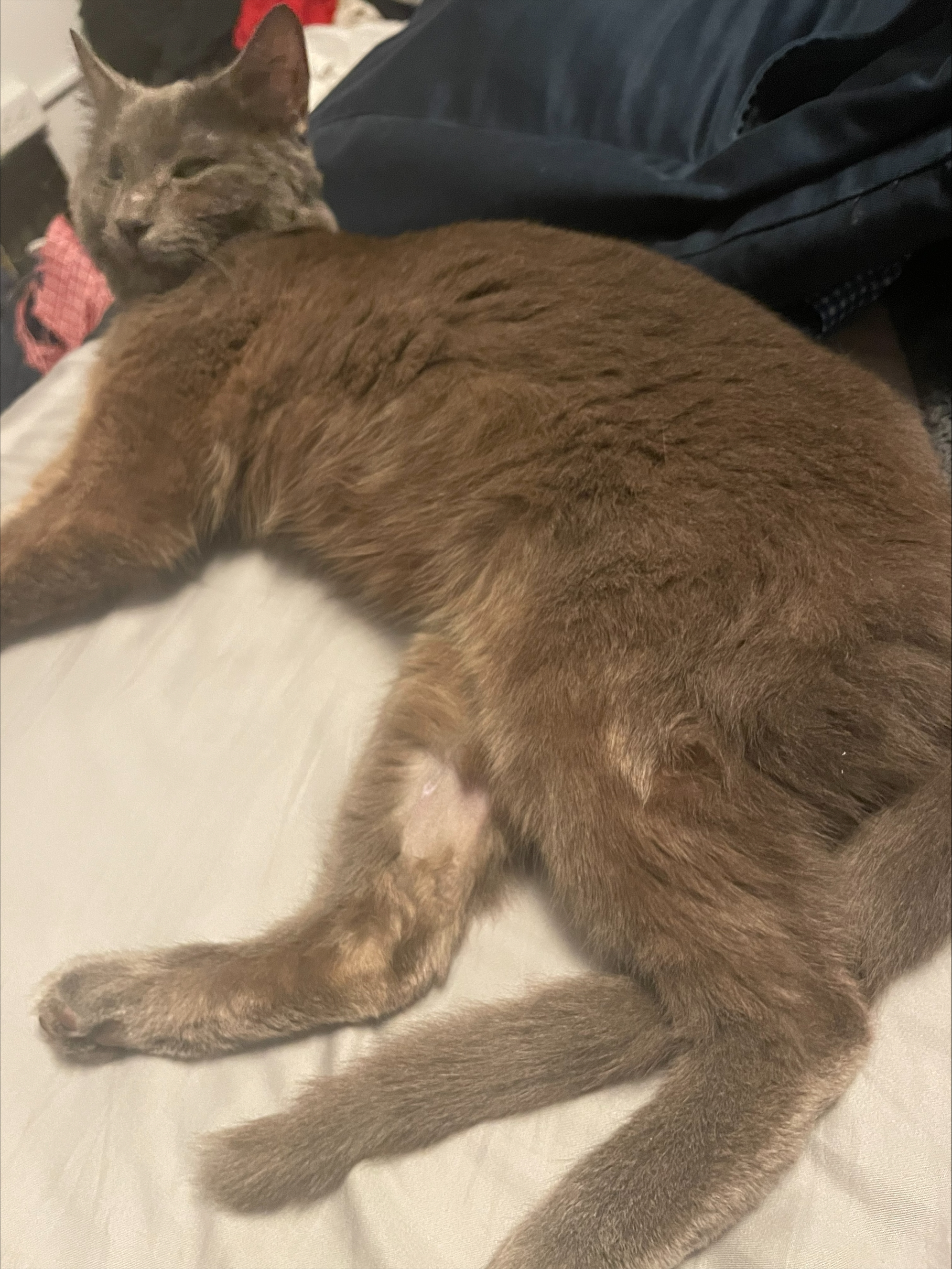
Leela, a Russian Blue kitty, barely weighed 4 pounds, even though she was 2-year-old.
She had a rough start in life: rescued on the street with “a really bad eye infection,” she eventually lost her right eye.
Leela was snotty, congested and skinny
Her owner remembers: “she had respiratory issues and congestion, and often made snorting and gurgling noises.”
In addition, “I wiped her nose 10 days a day. She threw up 3 to 4 times a week.”
Antibiotics, nose drops and cortisone (every other day for a year) didn’t really help the congestion and “the snot.”
She was suspected to have an elongated soft palate, which is a condition (rare in cats, common in dogs) where the back end of the roof of the mouth blocks the flow of oxygen.
After an exam, we suspected a different condition: a polyp in her nose (nasal polyp).
Confirming and removing it would require heavy sedation.
Her owner “felt very nervous with her going under sedation since she had breathing problems.”
However, she “was excited to finally get some answers about what was ailing her.”
During her physical exam, and throughout the day, there was a greenish discharge coming out of her nostrils.
After putting Leela under sedation, we opened her mouth and confirmed a polyp sitting above her soft palate – over the roof of her mouth.
We removed it, and were surprised by its size: 1.5 x 0.5 x 0.5 inches!
No wonder she wasn’t growing properly…

Leela’s huge polyp, next to a quarter.
Thankfully, her breathing improved as soon as the polyp was removed.
Leela went home on the next day, on pain medications and antibiotics.
We also prescribed a short course of cortisone to try to prevent a recurrence.
“I was so relieved and overjoyed” remembers her owner.
One week later, the biopsy results confirmed that the mass was a benign polyp.
What is a nasal polyp?
A nasal polyp is a small, non-cancerous (aka benign) growth.
The full name is naso-pharyngeal polyp.
It typically starts from the lining of the middle of the ear.
Sometimes it grows through the eardrum and up the ear canal.
And sometimes, as in Leela’s case, it grows into the back of the throat, until it dangles over the soft palate, which is the soft tissue at the very back of the roof of the mouth.
When the polyp grows into the throat, it blocks the airway.
This explains the symptoms Leela’s owner had noticed, such as:
. Noisy breathing or snoring as air struggles to get past the polyp.
. Gagging, coughing, or difficulty swallowing, because the growth is in the way.
. Nasal discharge because the nasal passages are partially blocked.
So a nasal polyp is a benign lump that has grown into a spot where it physically blocks a cat’s airway and interferes with their ability to breathe and swallow comfortably.
How did Leela do right after polyp removal?
Only 2 days after surgery, the news was good:
. “Leela seems better than I’ve ever seen her.”
. “It doesn’t even seem like she just had a procedure 2 days ago.”
. “She’s hasn’t been snotty at all, and has not made her congestion noises at all. Just a lot of purring and meowing.”
. “Before the surgery, she often slept and rarely ever played.”
. “Since the surgery, she has been playing a lot and showing interest in toys she barely even noticed before.”
. “She’s also been busy smelling every inch of the house. Her sense of smell has definitely improved after removing that huge polyp.”
How is Leela doing 1 year after polyp removal?
One year later, the update was still a pleasure to read:
. “I am overjoyed that Leela is feeling so much better.”
. “Leela used to sleep most of the day. Now she is much more energized and running around a lot. She has the zoomies a lot and loves playing with her toys!”
. “She is also eating much more than she used to! Pre-surgery, she was under 4 pounds. She is now 6.5 pounds.”
. “She’s hasn’t been snotty at all and hasn’t sounded congested!”
. “She is happier and healthier than ever and we are incredibly grateful to everyone who helped Leela get to this point.”
. “Overall Leela is the best she has ever been and is thriving.”
. “Thank you so much for healing her! We are so grateful she is living a happier and healthier life!”
And the best comment a surgeon could ever hear: “This procedure has been life changing for her!”
If you would like to learn how we can help your pet with safe surgery and anesthesia, please contact us through www.HRVSS.com
Never miss a blog by subscribing here: www.HRVSS.com/blog
Phil Zeltzman, DVM, DACVS, CVJ, Fear Free Certified
Pete Baia, DVM, MS, DACVS
www.HRVSS.com
